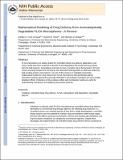Mathematical modeling of drug delivery from autocatalytically degradable PLGA microspheres — A review
Author(s)
Ford Versypt, Ashlee N.; Pack, Daniel W.; Braatz, Richard D.
DownloadBraatz_Mathematical modeling.pdf (571.6Kb)
PUBLISHER_CC
Publisher with Creative Commons License
Creative Commons Attribution
Terms of use
Metadata
Show full item recordAbstract
PLGA microspheres are widely studied for controlled release drug delivery applications, and many models have been proposed to describe PLGA degradation and erosion and drug release from the bulk polymer. Autocatalysis is known to have a complex role in the dynamics of PLGA erosion and drug transport and can lead to size-dependent heterogeneities in otherwise uniformly bulk-eroding polymer microspheres. The aim of this review is to highlight mechanistic, mathematical models for drug release from PLGA microspheres that specifically address interactions between phenomena generally attributed to autocatalytic hydrolysis and mass transfer limitation effects. Predictions of drug release profiles by mechanistic models are useful for understanding mechanisms and designing drug release particles.
Date issued
2012-10Department
Massachusetts Institute of Technology. Department of Chemical EngineeringJournal
Journal of Controlled Release
Publisher
Elsevier
Citation
Ford Versypt, Ashlee N., Daniel W. Pack, and Richard D. Braatz. “Mathematical Modeling of Drug Delivery from Autocatalytically Degradable PLGA Microspheres — A Review.” Journal of Controlled Release 165, no. 1 (January 2013): 29–37.
Version: Author's final manuscript
ISSN
01683659